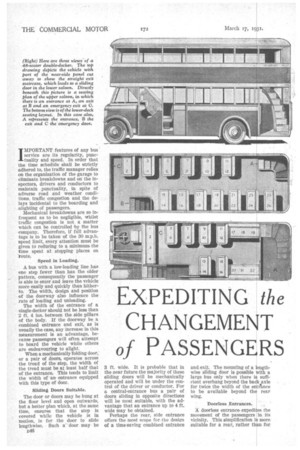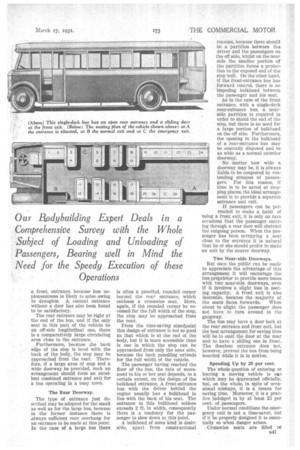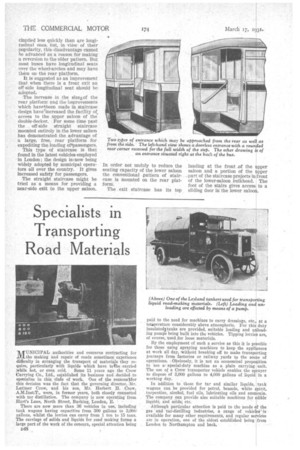EXPEDITING the
Page 116

Page 117

Page 118

If you've noticed an error in this article please click here to report it so we can fix it.
CHANGEMENT
of PASSENGERS IMPORTANT features of any bus service are its regularity, punctuality and speed. In order that the time schedule shall be strictly adhered to, the traffic manager relies on the organization of the garage to eliminate breakdowns and on the inspectors, drivers and conductors to maintain punctuality, in spite of adverse road and weather conditions. traffic congestion and the delays incidental to the boarding and alighting of passengers.
Mechanical breakdowns are so infrequent as to be negligible, whilst traffic congestion is not a matter which can be controlled by the bus company. Therefore, if full advantage is to be taken of the 30 m.p.h. Speed limit, every attention must be given to reducing to a minimum the time spent at stopping places en route.
Speed in Loading.
A bus with a low-loading line has one step fewer than has the older pattern, consequently the passenger is able to enter and leave the vehicle more easily and quickly than hitherto. The width, design and position of the doorway also influence the rate of loading and unloading.
The width of the entrance of a single-decker should not be less than 2 ft. 4 ins, between the side pillars of the body. If the doorway be a combined entrance and exit, as is usually the case, any increase in this measurement is an advantage, because passengers will often attempt to board the vehicle while others are endeavouring to alight.
When a mechanically folding door, or a pair of doors, operates across the tread of the step, the width of the tread must be at least half that of the entrance. This tends to limit the width of an entrance equipped with this type of door.
Sliding Doors Suitable.
The door or doors may be hung at the floor level and open outwards, but a better plan which, at the same time, ensures that the step is covered while the vehicle is in motion, is for the door to slide lengthwise. Such a door may be D43 3 ft. wide. It is probable that in the near future the majority of these sliding doors will be mechanically operated and will be under the control of the driver or conductor. For a central-entrance bus a pair of doors sliding in opposite directions will be most suitable, with the advantage that an entrance up to 4 ft. wide may be obtained.
Perhaps the rear, side entrance offers the most scope for the design of a time-saving combined entrance and exit. The mounting of a lengthwise sliding door is possible vith a large bus only when there i sufficient overhang beyond the back axle for twice the width of the entAnce to be available beyond the rear wing.
' Doorless Entrances.
X doorless entranceexpedites the movement of the passengers in its vicinity. This simplification ig more suitable for a rear, rather than for
a front, entrance, because less unpleasantness in likely to arise owing to draughts. A central entrance without a door has also been found to be satisfactory.
The rear entrance may be right at the end of the bus, and if the only seat in this part of the vehicle be an off-side longitudinal one, there Is a comparatively large circulating area close to the entrance.
Furthermore, because the back edge of the step is level with the back of the body, the step may be approached from the rear. Therefore, if a large area of step and a wide doorway be provided, such an arrangement should forin an excellent combined entrance and exit for a bus operating in a busy town.
The Rear Doorway.
The type of entrance just described may be adopted for the small as well as for the large bus, because in the former instance there is always sufficient rear overhang for an entrance to be made at this point. In the case of a large bus there Is often a panelled, rounded corner beyond the rear entrance, which encloses a cressvvise seat. Here, again, if the rounded corner be recessed for the full width of the step, the step may be approached from the rear.
From the time-saving standpoint this design of entrance is not so good as that which is at the end of the body, but it is more accessible than is one in which the step can be approached from only the near side, because the back panelling extends for the full width of the vehicle.
The passenger having reached the floor of the bus, the rate of movement to his or her seat depends, to a certain extent, on the design of the bulkhead entrance. A front-entrance bus with the driver behind the engine usually has a bulkhead in line with the back of his seat. The entrance in this bulkhead seldom exceeds 2 ft. in width, consequently there is a tendency for the passenger to slow down at this point.
A bulkhead of some kind is desirable, apart from constructional
reasons, because there should be a partition between the driver and the passengers on the off side, whilst on the near side the smaller portion of the partition forms a protec• tion to the exposed end of the step well. On the-other hand, It the front-entrance bus has forward control, there is no impeding bulkhead between the passenger and his seat.
As in the case of the front entrance, with a single-deck rear-entrance bus, a nearside partition is required in order to shield the end of the step, but there is no need for a large portion of bulkhead on the off side. Furthermore, the opening in the bulkhead of a rear-entrance bus may be centrally disposed and be as wide as a normal exterior doorway.
No matter how wide a doorway may be, it is always liable to be congested by contending streams of passengers. For this reason, if time is to be saved at stopping places, the ideal arrangement is to provide a separate entrance and exit.
If passengers can be persuaded to make a habit of using a front exit, it is only on rare occasions that the passenger entering through a rear door will obstruct the outgoing person. When the passenger has been occupying a seat close to the entrance it is natural that he or she should prefer to make an exit by the nearer doorway.
Two Near-side Doorways.
But once the public can be made to appreciate the advantage of this arrangement it will encourage the bus proprietor to provide more buses with two near-side doorways, even if it involves a slight loss in seating capacity. A front exit is also desirable, because the majority of the seats faces forwards. When about to alight the passenger does not have to turn around in the gangway.
The bus may have a door both at the rear entrance and front exit, but the best arrangement for saving time will be to omit the door at the rear and to have a sliding one in front. The doorlesa entrance does not, however, prevent tile bus from being boarded while it is in motion.
Speeding Up by 25 per cent.
The whole question of entering or leaving a moving vehicle is cle which may be deprecated officially, but, on the whole, in spite of occasional mishaps, it is a means for saving time. Moreover, it is a practice indulged in by at least 25 per cent. of passengers.
Under normal conditions the emergency exit is not a time-saver, but if it be properly designed it is essentially so when danger arises.
Crosswise seats are filled OT
emptied less quickly than are longitudinal ones, but, in view of their popularity, this disadvantage cannot be advanced as a reason for making a reversion to the older pattern. But most buses have longitudinal seats over the wheel-arches and may have thin on the rear platform.
It is suggested as an improvement that when there is a front exit an off-side longitudinal seat should be adopted.
The increase in the sizeof the rear platform and the improvements which havM,been made in staircase design have4increased the facility of access to the upper saloon of the double-decker. For some time past the off-side straight staircase mounted entirely in the lower saloon has demonstrated the advantage of a large, free, rear platform for expediting the loading oflpassengers.
This type of staircase is that found in the latest vehicles employed in London ; the design iSJROW being widely adopted by municipal operators all over the country. It gives Increased safety for passengers.
The straight staircase might be tried as a means for providing a near-side exit to the upper saloon. In order not unduly to reduce the seating capacity of the lower saloon the conventional pattern of staircase is mounted on the rear platform.
The exit staircase has its top
landing at the front .of the ipper saloon and a portion of the lpper _part of the staircase projects in front of the lower-saloon ,bulkhead. The foot of the stairs gives access' to a sliding door in the lower saloon.
























































































































































































